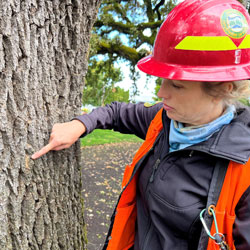Latest news
New guide to MOB is now available
Along with northern California, Oregon has the unfortunate distinction of being the first place in North America where Mediterranean oak borer has been detected. This tiny pest spreads a fungus to trees it infests. This fungus causes a vascular wilt that can kill Oregon white oaks. To help inform landowners and other land managers about the threat MOB poses, the Oregon Dept. of Agriculture has put out a
new guide. Also located under the insects drop-down.
EAB pocket guide translated into additional languages
The pocket guide to EAB for homeowners has been translated into four additional languages. The guide had been available in English and Spanish. The new translations make the pocket guide available in the next four most common languages spoken in Oregon – Vietnamese, Russian, Korean, and Mandarin Chinese. The guides can be found on this page under the heading detailed information about the emerald ash borer.
Mediterranean oak borer
An invasive insect from Europe, the Middle East, and North Africa that attacks oak trees has recently been found in several Oregon white oaks in Wilsonville. The Mediterranean oak borer (Xyleborus monographus) transmits multiple fungal species to the trees it infests. Some fungal species may cause a disease called oak wilt, which may kill oak trees in as little as two to three years. View
news release, fact sheet, and
FAQ for more information.
Pest experts in Oregon and California are still learning about the Mediterranean oak borer, an invasive pest whose first appearance in North America was on the U.S. West Coast. While there's much left to discover about this tiny beetle and the harm it can do to oak trees, what is known has been gathered by ODF and the Oregon Dept. of Agriculture staff into a
document to help land managers decide what steps they might take in response.
Tree health webinar series: Why are my trees dying?
ODF Forest Entomologist Christine Buhl and instructors from OSU Extension and the USDA Forest Service taught a four-part online course this summer on what diseases, pests or other health issues that are threatening Willamette Valley tree species.
View the webinar series.
Roundup of Oregon EAB news
Starting in October 2023, the
Oregon EAB Bulletin became the
Oregon Tree Health Threats Bulletin to reflect the range of pests facing Oregon's natural and urban forest trees. The new bulletin will continue to carry the latest information about the emerald ash borer in Oregon, as well as stories about Mediterranean oak borer and other new pests.
Maps
Pocket guides
Videos
Fact sheets
Posters
About the Forest Health Unit
The Forest Health Unit helps maintain and improve the health of Oregon's private and state-owned forests.
Our forest health professionals conduct aerial and ground surveys to monitor forest insects and tree diseases. They provide technical advice and training in the use of integrated pest management principles to help professional foresters and landowners meet their management goals and objectives.
Stewardship foresters, urban foresters, forest entomologists and pathologists can help landowners identify forest pest problems and develop strategies to manage pests. Contact a stewardship forester or the Forest Health Unit for more information.
View more information about the unit.
Factsheets & information
Email the Forest Entomologist for more information.
Quick insect pest diagnosis (start here)
Asian giant hornet
Bark beetles
Borers
Defoliators
Sap-feeding insects
Shoot, twig, cone, etc. insects
Forest pollinators
Control and management
Email the Forest Pathologist for more information.
Sudden oak death (SOD)
Help stop the spread of sudden oak death! Learn about this disease, its hosts, symptoms, eradication efforts, and what you can do to help.
Foliage diseases
Root diseases
Email the Forest Health Unit for more information.
Abiotic damage
Animal damage
Tree declines
Maps & data
Saving Oregon Ash video
For the past few years ODF's Forest Health team has been working with scientists from the USDA Forest Service on a first-of-its-kind effort to save as much of the gene pool of the Oregon ash tree from the expected ravages of the emerald ash borer. The borer is an invasive insect pest first seen in Oregon in summer 2022 that could nearly wipe out this tree as it has done to other ash species in the central and eastern U.S. Seed from throughout the Oregon range of our native ash species is being collected for long-term storage at two USDA Forest Service locations - Dorena Genetic Research Center in Cottage Grove and the National Seed Lab in Fort Collins, Colorado. Watch why this effort is so important to the future of Oregon wetlands and streamside woodlands.